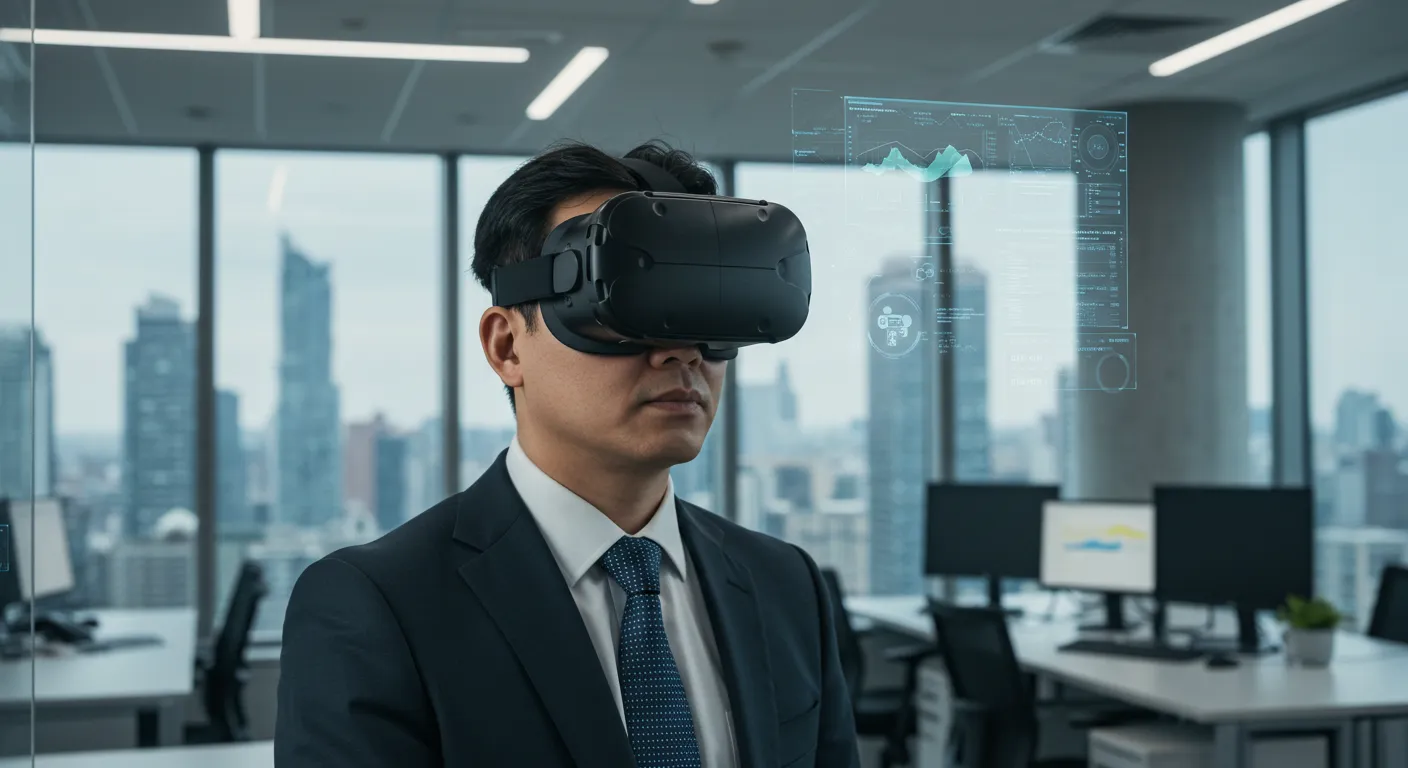How Virtual Reality is Redefining Remote Work and Collaboration

The way we work is undergoing a seismic shift, and at the heart of this transformation is the undeniable fact that virtual reality is redefining remote work.
No longer confined to science fiction, VR is now a tangible tool reshaping how teams collaborate, communicate, and create across distances.
As remote work becomes the norm rather than the exception, businesses are turning to immersive technologies to bridge the gap between physical separation and seamless collaboration.
But how exactly is virtual reality achieving this?
And what does it mean for the future of work?
Let’s dive into the ways VR is revolutionizing remote work, the challenges it faces, and why it might just be the ultimate game-changer for distributed teams.
The Evolution of Remote Work: From Zoom Calls to Virtual Offices
Remote work isn’t new, but its rapid acceleration during the pandemic exposed both its potential and its limitations.
Video conferencing tools like Zoom and Slack became lifelines for businesses, yet they often fell short in replicating the spontaneity and depth of in-person interactions.
Enter virtual reality—a technology that promises to transcend these limitations by creating immersive, interactive environments where teams can meet, brainstorm, and collaborate as if they were in the same room.
According to a 2023 report by Gartner, 55% of large enterprises will have adopted some form of immersive technology, including VR, by 2026.
This statistic underscores the growing recognition of VR’s potential to enhance remote work experiences.
Additionally, the integration of VR in remote work settings can lead to increased employee satisfaction and retention.
As workers find themselves feeling less isolated and more connected to their teams, the positive impact on mental health and productivity becomes evident.
Companies are beginning to realize that investing in VR technology not only enhances collaboration but also fosters a more engaged workforce.
For more insights on the evolution of remote work, check out Harvard Business Review.
How Virtual Reality Enhances Collaboration
- Immersive Meetings That Feel Real
Imagine stepping into a virtual boardroom where your colleagues’ avatars sit across the table, gestures and expressions mirroring their real-life counterparts. Platforms like Spatial and Meta’s Horizon Workrooms are already making this a reality. These environments go beyond flat video calls, allowing participants to interact with 3D models, share virtual whiteboards, and even “pass” objects to one another. - Breaking Down Geographical Barriers
Virtual reality eliminates the constraints of geography. A team member in New York can collaborate with a developer in Tokyo as if they’re standing side by side. This level of immersion fosters a sense of presence that traditional tools simply can’t match. - Enhanced Creativity and Problem-Solving
VR enables teams to visualize complex data and concepts in three dimensions. For example, architects can walk clients through virtual building designs, while engineers can troubleshoot machinery in a simulated environment. This hands-on approach sparks creativity and accelerates decision-making.
Moreover, the ability to simulate real-world scenarios allows teams to rehearse and refine their strategies in a risk-free environment.
This is particularly valuable in fields like emergency response training, where VR can replicate high-stakes situations without real-world consequences.
As industries continue to explore these possibilities, the applications for VR in collaboration will only expand.

The Challenges of VR in Remote Work
While the potential of virtual reality is immense, it’s not without its hurdles.
High costs, hardware limitations, and the learning curve associated with VR tools can be barriers to adoption.
Additionally, not all tasks require the level of immersion VR provides, making it essential for businesses to identify use cases where the technology adds genuine value.
Another concern is accessibility.
Not every employee has access to VR headsets or the technical know-how to use them effectively.
Companies must invest in training and infrastructure to ensure equitable access and maximize the benefits of VR.
Furthermore, the physical discomfort associated with prolonged VR use, such as motion sickness or eye strain, can deter employees from fully embracing the technology.
Addressing these health concerns through ergonomic design and user-friendly interfaces will be crucial for widespread adoption.
As organizations navigate these challenges, finding a balance between VR and traditional methods will be key to successful integration.
+ The Ethics of Virtual Reality: What We Need to Consider
Virtual Reality is Redefining Remote Work: Real-World Applications
Let’s look at how industries are leveraging VR to transform remote work:
| Industry | Use Case | Impact |
|---|---|---|
| Healthcare | Virtual surgeries and remote patient consultations | Enables specialists to assist in procedures from anywhere in the world. |
| Education | Virtual classrooms and interactive learning environments | Enhances engagement and makes education accessible to remote learners. |
| Manufacturing | Virtual prototyping and remote equipment maintenance | Reduces costs and speeds up production cycles. |
In the healthcare sector, for instance, VR is being used for training medical professionals, allowing them to practice procedures in a controlled environment.
This not only improves skills but also boosts confidence before they perform actual surgeries.
Similarly, in education, VR has the potential to transform how students learn by providing immersive experiences that textbooks simply cannot offer.
As more industries adopt VR, the impact on remote work will continue to grow, leading to innovative applications that redefine traditional practices.
The Future of Work: A Hybrid Reality
As virtual reality continues to evolve, it’s clear that the future of work will be a hybrid one—blending physical, remote, and virtual elements.
Companies like Microsoft and Meta are already investing heavily in VR solutions, signaling a shift toward more immersive work environments.
But the true power of VR lies in its ability to humanize remote work.
By fostering a sense of presence and connection, it addresses one of the biggest challenges of distributed teams: isolation.
Moreover, as technology advances, we can expect VR experiences to become more refined and accessible.
This evolution will likely include improved hardware, more intuitive software, and greater integration with existing workplace tools.
As these advancements unfold, businesses will be better equipped to leverage VR for a truly collaborative and engaging work environment.

Key Considerations for Adopting VR in Your Workplace
Before jumping on the VR bandwagon, businesses should consider the following:
- Identify Pain Points
Determine where VR can add the most value. Is it in training, collaboration, or customer engagement? - Invest in the Right Tools
Choose VR platforms that align with your team’s needs and technical capabilities. - Prioritize Accessibility
Ensure that all team members have access to the necessary hardware and training. - Measure ROI
Track the impact of VR on productivity, employee satisfaction, and business outcomes.
Additionally, fostering an open culture that encourages experimentation with VR can lead to innovative uses that may not have been previously considered.
Encouraging feedback from employees who use VR tools will also help refine processes and improve overall effectiveness.
As organizations take these steps, they’ll be better positioned to harness the full potential of virtual reality.
++ How VR is Helping Architects Design the Cities of Tomorrow
The Ethical Implications of VR in the Workplace
As with any emerging technology, VR raises important ethical questions.
How do we ensure data privacy in virtual environments?
What safeguards are in place to prevent misuse?
Companies must address these concerns proactively to build trust and ensure responsible adoption.
Moreover, the potential for VR to create hyper-realistic environments raises questions about the boundaries between work and personal life.
As employees engage in virtual spaces, companies should consider how to maintain a healthy work-life balance.
Establishing guidelines around VR usage can help mitigate these concerns while promoting a positive workplace culture.
Conclusion: A New Era of Work
There’s no denying that virtual reality is redefining remote work.
By creating immersive, interactive environments, VR is bridging the gap between physical and remote collaboration, unlocking new possibilities for creativity, efficiency, and connection.
While challenges remain, the potential of VR to transform the workplace is undeniable.
As businesses continue to explore and adopt this technology, we’re stepping into a new era of work—one where distance is no longer a barrier, and collaboration knows no bounds.
Tables
Table 1: VR Adoption by Industry (2023)
| Industry | Adoption Rate | Primary Use Case |
|---|---|---|
| Healthcare | 40% | Training, remote consultations |
| Education | 35% | Virtual classrooms, interactive learning |
| Manufacturing | 30% | Prototyping, equipment maintenance |
| Retail | 20% | Virtual stores, customer engagement |
Table 2: Benefits of VR in Remote Work
| Benefit | Description |
|---|---|
| Enhanced Collaboration | Creates a sense of presence and improves team interaction. |
| Cost Savings | Reduces travel and operational expenses. |
| Increased Engagement | Makes meetings and training sessions more interactive and memorable. |
| Improved Productivity | Streamlines workflows and accelerates decision-making. |
As we look to the future, one thing is clear: virtual reality is redefining remote work, and its impact will only continue to grow.
Whether you’re a business leader, a remote worker, or a tech enthusiast, now is the time to explore how VR can transform the way you work and collaborate.
The virtual office of tomorrow is here today—are you ready to step inside?
